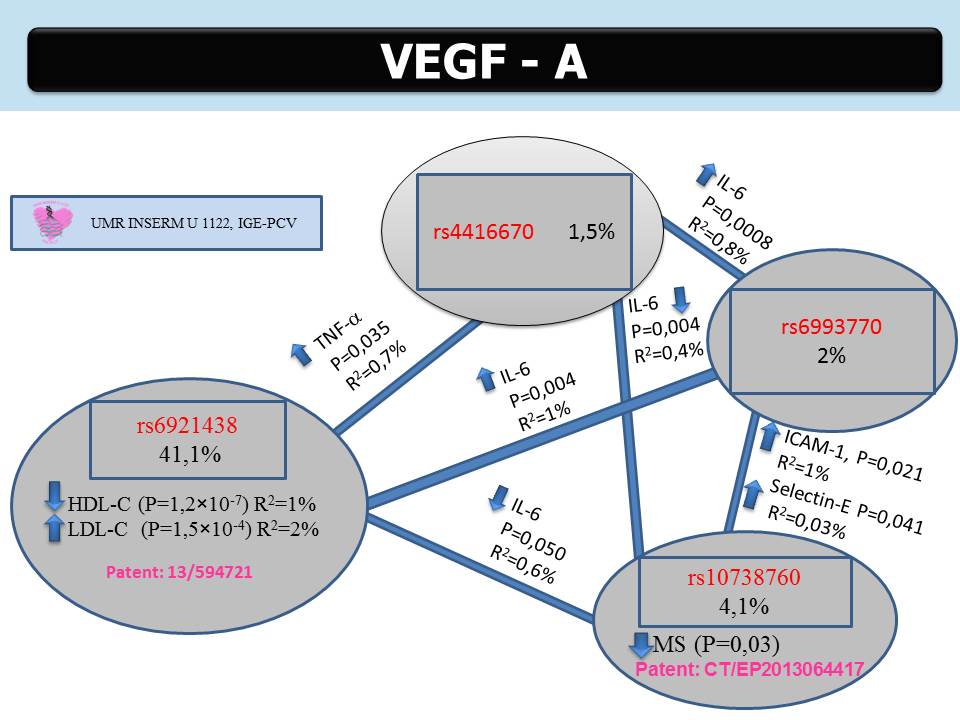Our scientific project consists of an integrative approach taking into account :
- the different metabolic pathways involved in cardiovascular pathologies around inflammation,
- the information collected from gene to protein via mRNA and
- the intermediate phenotypes present in plasma/serum and lymphocytes. In 2008, we combined this approach with a genome-wide strategy aimed at determining original markers of cardiovascular pathologies. From this strategy, we obtained interesting results for several biomarkers including Vascular Endothelial Growth Factor-A (VEGF-A) and leukocyte telomere length (LTL).
A. Epithelial Vascular Growth Factor A (VEGF-A) is an ideal biomarker for the integration of omics data into personalized cardio-vascular pathologies prediction/prevention/treatment strategies due to its function as a key molecule in angiogenesis, its involvement in the pathophysiology of cardio-vascular diseases and its high genetic heritability.
- The hereditary component of VEGF-A, initially described by our team, is higher than 60%, a result that was later validated in the Framingham cohort. A genetic component of this order is exceptional in genetic epidemiology studies.
- Up to about half of this heritability(48%) is explained by four genetic variants identified by a GWAS conducted by our Unit in collaboration with Framingham. Therefore, thanks to this widely characterized heritability, VEGF-A represents a unique biomarker for "omics" approaches.
- The four VEGF-A related variants identified by the GWAS have been demonstrated by our Unit to be associated with risk factors for cardio-vascular pathologies that are evaluated in most prevention programs, such as :
* Cholesterol levels;
* Blood pressure;
* Inflammatory molecules.
- The previously identified associations are under the influence of environmental risk factors for cardio-vascular pathologies, hence the possibility of controlling their effect through prevention strategies. Thus, "VEGF-omic" determinants can be used to regulate many risk factors for cardio-vascular pathologies and play an important role in prevention programs.

Divers international publications are issued from these results-list available at: http://www.vegfconsortium.org/publications/
The creation of the VEGF - "Vascular endothelial growth factor European Genomic Federation", in 2015, bringing together 20 partners under the leadership of the Unit Director.
Within the framework of this consortium, the Unit organizes from 2015, one annual meeting.
B. Leukocyte telomere length (LTL) has been associated with a large number of human diseases related to aging, such as CVD and its risk factors such as obesity and hypertension. A strong hereditary component (40-80%) has been identified. GWAS have identified genetic variants associated with this intermediate phenotype. However, none of these studies involved, or referred to, paediatric populations (< 18 years). Yet, childhood is a period of utmost importance for the determination of LTL and the study of its genetic determinants. To our knowledge, there are few cohorts of healthy children for whom GWAS data and LTL measurements are available. Therefore, using a GWAS approach, we have studied associations in adults and children to detect age- and environmental-dependent effects and to identify novel genetic determinants.
We have obtained interesting results on the genetic determinants of LTL, links with environmental factors such as BMI and identified new polymorphisms in children different from those in adults:
These results have led to important international publications (see publications list).
-
2 patents:
-
Brevet WO 2014006231 A1: "Association of Vascular Endothelial Growth Factor Genetic Variant with Metabolic Syndrome": (Inventeur: Sophie VISVIKIS-SIEST) - 2014 http://patents.google.com/patent/WO2014006231A1/en
- Brevet WO 2013093091 A2: "Genetic Factors in Blood Pressure" http://patents.google.com/patent/WO2013093091A2/en (Inventeurs: Sophie VISVIKIS-SIEST, Said EL SHAMIEH, Helena MURRAY, John LAMONT, Peter FITZGERALD) -
6. RECENT NATIONAL PROJECTS WITH IMPORTANT REGIONAL ISSUES:
-
Project "CARTAGE" (Innovative and patient-centered strategies in Cardiac and ARTerial AGEing, - fhu-cartage.com), 2015-2020
-
Project "FIGHT-HF" (Fighting Heart Failure) - ANR/"Future Investment Project"/RHU, 2015-2020
-
Project "LUE" ((Lorraine University of Excellence - A Global Engineering Initiative) - "Investment project for the future"/ISITE (Initiatives-Science - Innovation - Territories - Economy) with the "GEENAGE" Project (Functional Genomic, Epigenomic and ENvironment interplay to IMPACT the understanding, diagnosis and management of healthy and pathological AGEing), 2016-2026.
-
Chaire Gutenberg, 2019-2022.
-
Fondation Alzheimer – project: DYSLIP-AD - “Molecular mechanisms underlying dyslipidemias as risk factors for Alzheimer’s disease”, 2019-2022.
RECENT EUROPEAN PROJECTS
-
PROJECT 1
HORIZON 2020 (H2020 MSCA-RISE-2015) "MAST4HEALTH" (Mastic treatment for Healthy obese with NAFLD diagnosis) - Sucessfully achieved in 2020
-
PROJECT 2
"Interactions gene x gene x environment and personalized medicine of cardiovascular pathologies" is co-financed by the European Union within the framework of the Operational Programme ERDF-ESF Lorraine and Vosges Massif 2014-2020" and is accompanied by the following emblem of the European Union. Sucessfully achieved in 2020
-
PROJECT 3
"VEGF-A in the triangulation of oncology risks" is co-financed by the European Union within the framework of the Operational Programme ERDF-ESF Lorraine and Vosges Massif 2014-2020" and is accompanied by the following emblem of the European Union. Sucessfully achieved in 2020